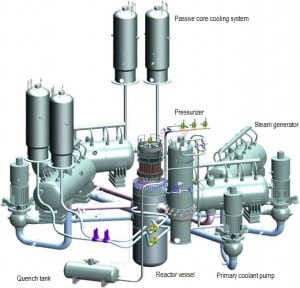
Source: gidropress.podolsk.ru
used with permission of АО ОКБ “ГИДРОПРЕСС”
In general, a reactor startup after refueling is a startup from a cold condition since refueling requires the Reactor Coolant System (RCS) to be cooled down and depressurized. The initial conditions are: the NSSS – Nuclear Steam Supply System is in the “cold shutdown” mode, which means Tavg = 30°C, pressure = near atmospheric, boron concentration is sufficient to yield 10% shutdown margin, and RCPs – Reactor Coolant Pumps are off. Prior to each point of the procedure above, compliance with the plant Technical Specifications must be verified.
The NSSS heat up from Cold Shutdown (MODE 5) to Hot Standby (MODE 3) is performed by reactor coolant pumps which are very powerful (they can consume up to 6 MW each), and therefore its work together with a decay heat can be used for heating the primary coolant before a reactor startup. Reactor coolant system pressure must be increased to satisfy net positive suction head requirements to operate the reactor coolant pumps, and reactor coolant pumps are started sequentially. The primary plant heat-up rate is limited to about 30°C per hour to minimize internal stress in the material of the pressure vessel, primary piping, and other components.
The RCPs are used because a pressurized water reactor may have a positive moderator temperature coefficient at low temperatures. An operation (reactor criticality) with a positive moderator temperature coefficient caused by the amount of soluble boron in the moderator (see: MTC) is prohibited. Therefore the heat up by chain fission reaction is prohibited. The plant is brought to near operating temperatures (e.g., Tin ~ 275°C) with reactor coolant pump heat before the reactor is made critical. Heat exchangers of the residual heat removal system are bypassed to allow heat up. Since the coolant volume increases (due to thermal expansion) during its heat up, its excess must be removed from the reactor coolant system.

Pressure in the pressurizer is controlled by varying the temperature of the coolant in the pressurizer. For these purposes, two systems are installed. Water spray system and electrical heaters system. The submerged electrical heaters are designed to increase the pressure by evaporating the water in the vessel and the heat pressurizer. Water pressure in a closed system tracks water temperature directly; as the temperature rises, the pressure goes up.
When the reactor coolant temperature and pressure reach the target value (e.g., 275°C and 16 MPa), the RCS heat up is finished. The temperature of the coolant is then maintained through the balanced use of reactor coolant pump heat input and a steam dump system that releases steam to the main condenser. The next step in the startup of the plant is to take the reactor critical.